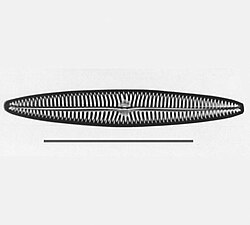Navicula
| Navicula | |
|---|---|

| |
| Navicula bullata | |
| Scientific classification | |
| Clade: | SAR |
| Phylum: | Ochrophyta |
| Class: | Bacillariophyceae |
| Order: | Naviculales |
| Family: | Naviculaceae |
| Genus: | Navicula Bory de Saint-Vincent, 1822 |
| Type species | |
| Species | |
Navicula is a genus of boat-shaped diatom algae, comprising over 1,200 species.[1] Navicula is Latin for "small ship", and also a term in English for a boat-shaped incense-holder.[2]
Diatoms — eukaryotic, primarily aquatic, single-celled photosynthetic organisms — play an important role in global ecology, producing about a quarter of all the oxygen within Earth's biosphere, often serving as foundational organisms, or keystone species in the food chain of many environments where they provide a staple for the diets of many aquatic species.
Mobility[]
Navicula diatoms are known for their ability to creep about on each other and on hard surfaces such as microscope slides.[3][4][5][6] It is thought[by whom?] that around the outside of the navicula's shell is a girdle of protoplasm that can flow and thus act as a tank track.[citation needed]

Navicula tripunctata
type species scale= 50 µm
Lyrella hennedy

Navicula oblonga

Navicula oblonga
References[]
- ^ M.D. Guiry (2015). Guiry, M.D.; Guiry, G.M. (eds.). "AlgaeBase". World-wide electronic publication, National University of Ireland, Galway. Retrieved 2015-08-15.
- ^ Oxford English Dictionary, "Navicula. 3"
- ^ Navicula Diatom: Youtube video
- ^ Gupta, S; Agrawal, SC (2007). "Survival and motility of diatoms Navicula grimmei and Nitzschia palea affected by some physical and chemical factors". Folia Microbiol (Praha). 52 (2): 127–34. doi:10.1007/BF02932151. PMID 17575911. S2CID 20030370.
- ^ J Microbiol Methods. 2013 Mar;92(3):349-54. doi: 10.1016/j.mimet.2013.01.006. Epub 2013 Jan 18. Semi-circular microgrooves to observe active movements of individual Navicula pavillardii cells. Umemura K1, Haneda T, Tanabe M, Suzuki A, Kumashiro Y, Itoga K, Okano T, Mayama S.
- ^ M.A. Harper & J.F. Harper (1967). "Measurements of diatom adhesion and their relationship with movement". British Phycological Bulletin. 3 (2): 195–207. doi:10.1080/00071616700650051. ISSN 0374-6534.
External links[]
- Navicula Image (Missouri State University)
- Navicula sp. Diatoms from Guaíba island, Rio de Janeiro.
- Bacillariophyceae - Navicula Ohio University
- "Navicula". WoRMS. World Register of Marine Species.
 Media related to Navicula at Wikimedia Commons
Media related to Navicula at Wikimedia Commons
- Navicula
- Diatom genera
- Diatom stubs




